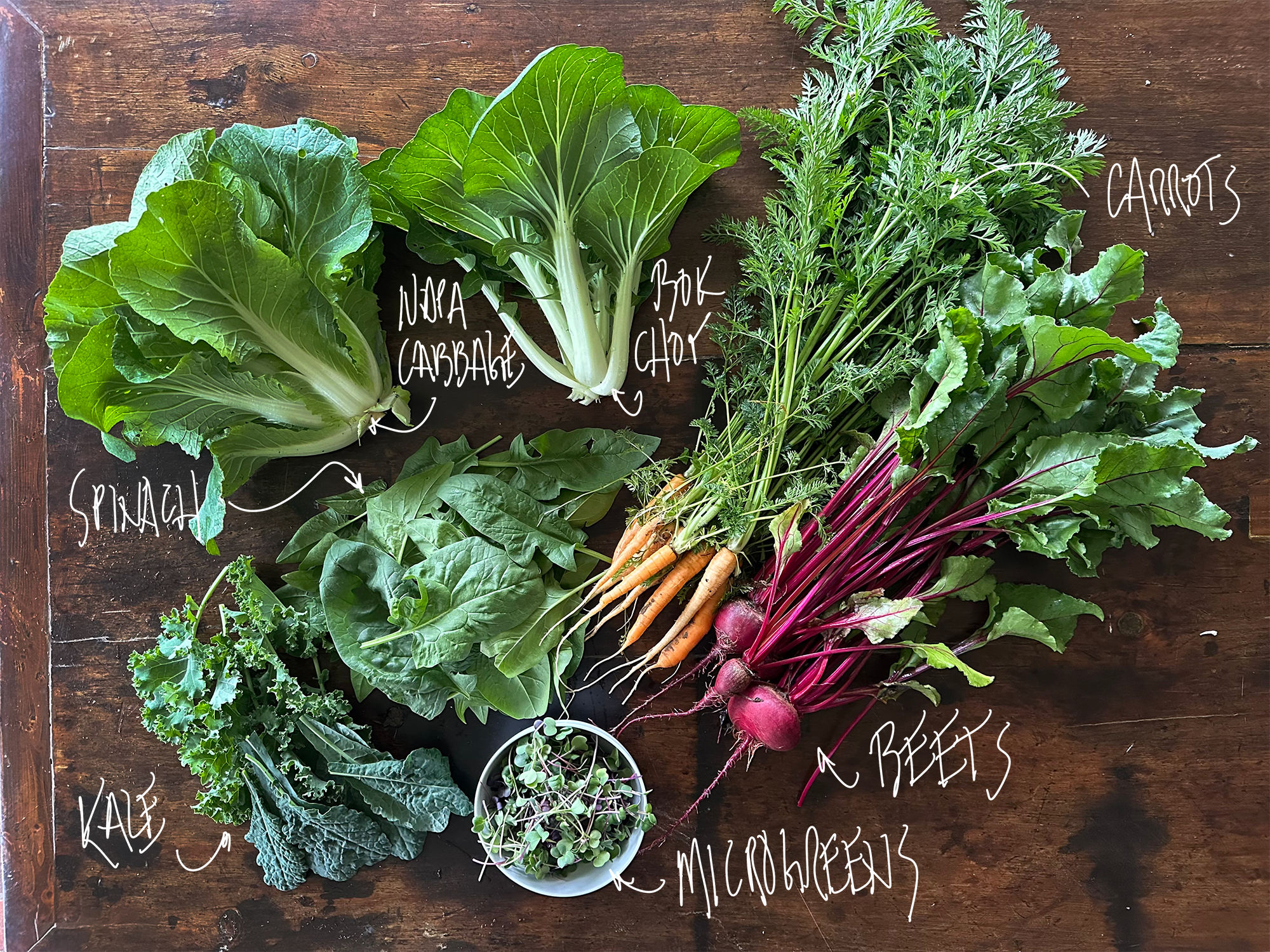2025 Season | Week 3
“Plant a radish, get a radish, never any doubt. That's why I love vegetables, you know what they're about!”
Tom Jones
It’s the first week for radish. One of the quickest crops to go from seed to table (about 22 days!) These are delicious. We should have more in coming weeks, then we’ll step up to the larger Diakon radish. Romaine heads are almost ready (next week) as well as scallions too. It’s gettin’ real.
Our beets and carrots are ending their run. Some of the carrots are getting woody. You can tell as they are hard to cut. Most are great. The beets are doing a similar drill and they haven’t grown very large. We’re going to harvest the rest and put them in the trailer for those who’d like to use them.
Here’s what’s in your crate this week.
-
BOK CHOY 101 - As far as cabbage goes, bok choy stands apart. With a crunchy, celery-like texture when cooking times are short, to a unique, creamy texture when left in the pan a little longer. You can steam, stir fry, broil, sauté or eat it raw by mixing it in a salad or slaw (so good it makes us rhyme!). Check out our blog for one of our favorite bok choy recipes!
EAT NOW - Wash bok choy by swishing in a bowl of water to remove dirt between stalks. Baby bok choy can be cooked whole or by halving. For larger varieties, separate leaves from stalk to prevent overcooking.
EAT LATER - Store unwashed bok choy in a perforated plastic bag in the refrigerator for up to 3-5 days. To freeze, blanch, then remove excess water and store them in an airtight bag. Good for up to 10 mo.
To blanch, bring a pot of lightly salted water to a rolling boil. While you wait for boil, prepare an ice bath. Once boiling, drop veggies into water - water should return to boil within a minute otherwise you have too much veg for the water. Once boil has returned, cook for 1-5 min until veg has a vibrant color. Immediately put into ice bath to stop cooking.
RECIPES
-
BEETS 101—Beets are healthy, versatile, taste amazing, and look beautiful. One of the best things about them is that they keep well before and after cooking, and every part is edible and delicious. Beets can be broiled, steamed, grilled, or roasted, our favorite. (We like cut beets roasted in olive oil and salt and pepper the best!)
EAT NOW—Roots: Just before cooking, scrub the beets well and remove any scraggly leaves and rootlets. If your recipe calls for raw beets, peel them with a knife or a veggie peeler, then grate or cut them according to the recipe. To remove the skins, roast them in foil or boil them, and the peels will slip right off.
Beet greens: Wash the leaves in a basin of lukewarm water to remove grit. Remove the thicker stems. Depending on use, cut the greens into appropriately sized pieces.
OR LATER - To Freeze: Beet Roots: Boil or bake beets until done. Cool them in ice water or let them come to room temperature. Remove peels. Trim the beets into 1/4-inch slices or keep them whole (if they are small). Place in a freezer bag and remove as much air as possible. Seal and freeze. Beet greens: Blanch wash beet greens for 2-3 minutes in hot boiling water. Immediately dunk in ice water to stop the cooking process. Then drain and pack into airtight containers. Freeze them in “balls” on a cookie sheet, then pop them into a freezer bag for the perfect portion.
DON’T TOSS THOSE BEET GREENS! - Beet greens are delicious! Here are some simple ways to use them: Use them for making vegetable stock, toss them into a salad — especially the smaller leaves, braised with a bit of olive oil, garlic, and pepper flakes, toss in a smoothie, add them to an omelet, frittata, or quiche, stir them into a pasta sauce in the final stages, add to a soup, like you would kale or spinach, turn them into a pesto
RECIPES
-
CARROTS 101 - Crunchy, tasty, and highly nutritious, carrots are one of our favorite root vegetables. Carrots are a great source of beta carotene, fiber, vitamin K1, potassium, and antioxidants! We’re used to seeing orange carrots, but did you know carrots come in a variety of colors like yellow, white, red, and even purple? Both the root and the greens are edible - the leaves make for a great garnish or addition to pesto. The greens have a slightly bitter taste that compliments the sweetness of the root.
EAT NOW - Because we don’t use pesticides, our carrots don’t need to be peeled. Simply rinse and scrub any dirt before use. Eaten raw, carrots are great whole, julienned, speared, or chopped. Carrots can be boiled, sautéd, stir fried, or even air fried! Fresh carrot tops can be chopped into a green salad or stir-fry too! The greens can also be dried and used as an herb like parsley.
OR LATER - To avoid “floppy carrots,” remove the green tops as soon as you can, leaving about an inch of stems. Save the greens separately. Then, place root in a bag in the fridge or in a bin of water (like celery) to keep them crisp, changing out the water every few days. Uncut carrots will last in the fridge for up to 4 weeks. They can also be chopped, then blanched and placed in an airtight container in the freezer to keep longer. Store the tops in a separate bag in the fridge. Or put them in a plastic Ziplock in your freezer and use them to make DIY vegetable or chicken stock.
To blanch, bring a pot of lightly salted water to a rolling boil. While you wait for boil, prepare an ice bath. Once boiling, drop veggies into water - water should return to boil within a minute otherwise you have too much veg for the water. Once boil has returned, cook for 1-5 min until veg has a vibrant color. Immediately put into ice bath to stop cooking.
RECIPIES
-
KALE 101 - Wash leaves in lukewarm water. If your greens have thick stems, remove them by folding each leaf in half and slicing out the stem. Then, stack the leaves up and slice diagonally into 1” wide strips.
EAT NOW - Wrap unwashed chard or kale in a sealed plastic bag in the crisper drawer of the fridge. Best used very fresh, but may last for a week. To freeze, blanch washed greens, rinse in cold ice water, drain, and pack into airtight containers.
OR LATER - Swiss chard or kale can both be eaten raw or cooked. A longer cooking time is best as it brings out the sweetness in the greens. Extremely high in vitamin K and vitamin A, these nutrient-dense greens can help combat cancer and reduce blood pressure! Chard and kale can be used interchangeably with: collards, turnip greens, beet greens, broccoli raab, mustard greens, dandelion, and spinach.
-
Microgreens 101—Before use, rinse gently in cool (not hot or cold) water to remove excess dirt. Pat or spin dry, and you’re good to go! Pat or spin dry your greens to remove excess moisture (moisture = mush!). Place loosely in a plastic bag or container and put in the fridge. They will keep for up to one week.
Eat These Immediately!
-
NAPA CABBAGE 101 - Napa Cabbage has many uses, as well as great storage capacity when chilled. Use leaves for soups and noodles, the crunchy rib for stir-fry or fermented kimchi, the crisp outer layer is great for salads and wraps, while the inner layer is best for steaming or poaching - we recommend trying it all!
EAT NOW - Remove any floppy or yellowed outer leaves, then chop off stem and halve. Remove core (V cut) and separate leaves. Rinse, dry, then chop or shred.
EAT LATER - Store dry, unwashed cabbage in the veggie bin of your fridge for months. Once cut, wrap in sealed plastic bag and continue to refrigerate for several weeks.
RECIPES -
yankeestreetfarm.com/ blog/grilled-slaw-withginger- and-sesame
-
SPINACH 101 - This versatile, leafy green is packed with nutrients and antioxidants. Plus, it’s a great source of plant-based iron! It can be eaten raw or lightly cooked. To get the most out of your cooked spinach, briefly blanch, steam, or sauté until it turns bright green.
EAT NOW - Swish leaves in basin of cool water and let sit for a minute to remove grit. Then, spin or pat dry. Ready to eat raw! If you want to cook your spinach, blanch, steam, or sauté til just wilted. Color will brighten beautifully to signal it is done. Serve immediately.
OR LATER - Keep dry, unwashed greens in a sealed plastic bag in the refrigerator up to 1 week. To freeze, blanch washed greens for 1 minute, drain, and pack into airtight containers and place in freezer - will keep for up to a year. Frozen spinach is a great addition to smoothies!
To blanch, bring a pot of lightly salted water to a rolling boil. While you wait for boil, prepare an ice bath. Once boiling, drop veggies into water - water should return to boil within a minute otherwise you have too much veg for the water. Once boil has returned, cook for 1-5 min until veg has a vibrant color. Immediately put into ice bath to stop cooking.
RECIPES
-
Radishes 101 Our radishes are delicious when raw, with a sprinkle of salt or butter. The spicy, raw flavor is a wonderful addition to slaws and salads, or you can sauté and roast radishes to bring out a more subtle earthly flavor. You can even try them grilled!
EAT NOW Scrub radishes well to remove dirt, then trim stem and rootlets. Slice, chop, or mince or leave them whole. Delicious raw or cooked.
OR LATER Remove leaves and store unwashed greens in loosely wrapped plastic bag in crisper. Store unwashed roots in plastic bag in fridge for up to 1 week.
RECIPES

